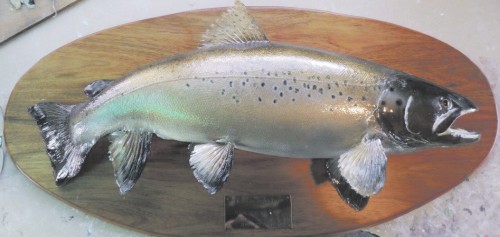 Fish mount restoration
Fish mount restoration
Presented from Issue 116, June 2015
I’ve been practising fish taxidermy for several years, starting with skin mounts and fibreglass reproductions, and more recently have taken on the restoration of old mounts.
With modern day products and techniques there is no reason why a properly crafted fish skin mount should not last a lifetime. However, we’ve all seen old (and some not so old) mounts hanging on pub walls, in fishing shops or in mates sheds that have weathered badly over time . Not all old mounts need a make over. Those with least deterioration may still look rather discoloured but are best left alone with the vintage look and have a charm, character and history of their own. The worse for wear jobs with the curled fins and shrivelled heads can certainly be brought back to life.
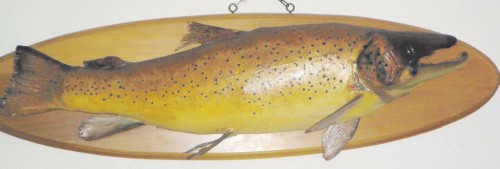 |
| A sad and tired representation of a great catch before restoration. |
Symptons
The signs of a prematurely aged skin mount are fairly obvious. They can typically lack colour and are often light brown or yellowish in appearance, sometimes with little detail or spot pattern. The body may also appear distorted. The head and gill covers can show signs of shrinkage and grease bleed with unsightly wrinkled areas and discolouration from yellow to dark brown or black. An improperly installed or wrong sized glass eye will also add to the unnatural appearance. Fins are thin by nature and are particularly vulnerable to the elements , they may look curled, split and lacking colour, also very brittle to the touch.
Cause
Years ago when big trout were plentiful, and taxidermy techniques not so readily available, many big fish were subject to rather crude practises, the results of which can be seen hanging on walls today. Colour fade and yellowing may be due to a number of factors. The yellow/light brown is the fishes dried natural skin showing through. The mount may not have been painted at all initially, or very sparsely with a low grade paint and ultra violet light has taken its toll over the years. It can also be caused by over application of varnish.
Head discolouration and wrinkling is due to shrinkage and grease bleed. If the fish’s natural head was used on the mount these problems will occur if the head was not thoroughly de fl eshed or de greased before mounting. Greasy cold water fish such as trout and sea fish are prone to this. It can also be noticeable at the fin butts and along the back of the fish, again if the skin was not de greased .
Frayed, curled and split fins are also a common problem. Quite often no protective coating or paint was applied to the fins, that combined with continuous sunlight and heat will make the fins become very brittle and distorted. Unnatural body shape and misaligned fins is usually due to incorrect set up of the skin in the first place , or an unsuitable filler used under the skin to form the body of the mount.
I’ve covered the most obvious points here, there’s other issues that can occur such as cracks and indents , improperly fitted eyes and loose attachment to display board, all of which can be fixed.
Remedy
Most damaged skin mounts can be restored with minimal repair work. In more extreme cases where damage is extensive the best option is to virtually start from scratch by making a mould of the worn mount and casting a modified fibreglass copy.
Sometimes all a mount needs is a fresh paint job . It is fairly straightforward fix and will transform the look of the fish , giving it life especially when finished with the appropriate varnish. It has been said that a poorly mounted fish with a good paint job will look far better than a well mounted fish with a poor paint job!
Head distortion and discolouration is a bit trickier to fix if the customer wishes to retain the original head on the fish. The shrunken and discoloured areas need to be cut out of the head to ensure accumulated grease is removed, a resin is then used to fill and re model the damaged areas. Sometimes it is easier to remove the head and replace with a fibreglass cast copy. In fact, to prevent these problems occurring in the first place it is preferable for the taxidermist to use a cast copy of the original head when first making the mount.
Fin and tail damage can be repaired and fins strengthened to assure the problem doesn’t re-occur, if too deteriorated they can be removed and replaced with an artificial copy.
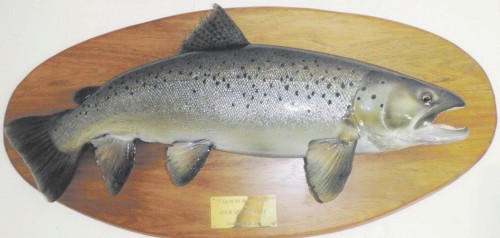 |
 |
| Two beautifully restored mounts. |
Conclusion
All fishermen have a sentimental attachment to their prize catch on the wall, it’s a permanent talking point amongst fishing buddies with many memories and yarns swapped over the years.
The mount should justify not only the size but the beauty of the original fi sh. It’s always a shame to me to see stuffed fi sh that are a shadow of their former glory and relegated to the shed and in some cases not even hung on the wall, especially when the mount may not be particularly old and would have cost a bit to be done in the fi rst place. Minimal restoration can make major improvement to the look and life of a mount, without altering it drastically and losing the charm and character of the original fi sh.
One aspect that often gets over looked is care for the trophy. No skin mount, no matter how well made likes extreme heat. We all know how hot fi shing shacks can get once the log fi re is stoked up. Use a bit of common sense and don’t hang your trophy in close proximity to a scorching hot fl ue, the heat will take its toll over time. If you wish to hang a trophy in that sort of environment then maybe opt for a fi breglass reproduction.
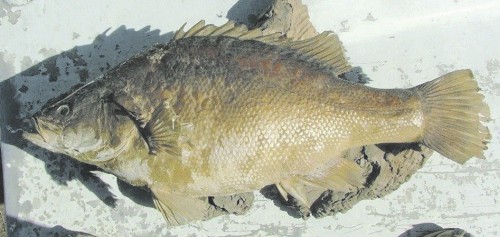 |
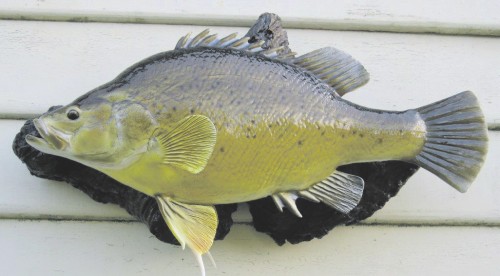 |
| Dramatic before and after shots. |
Don’t be put off by this article or by what you’ve seen hanging on walls from having a skin mount trophy made. Not all fi sh are suitable for skin mount but trout certainly e, and at the end of the day most anglers opt to have their actual fi sh hanging up as opposed to a plastic copy. If you’ve got a big fi sh you want immortalised, do a bit of research before you get the job done, and if all correct techniques and products are used by the taxidermist then your trophy should last a lifetime and will not need a restoration job in the future.
John Wilesmith
